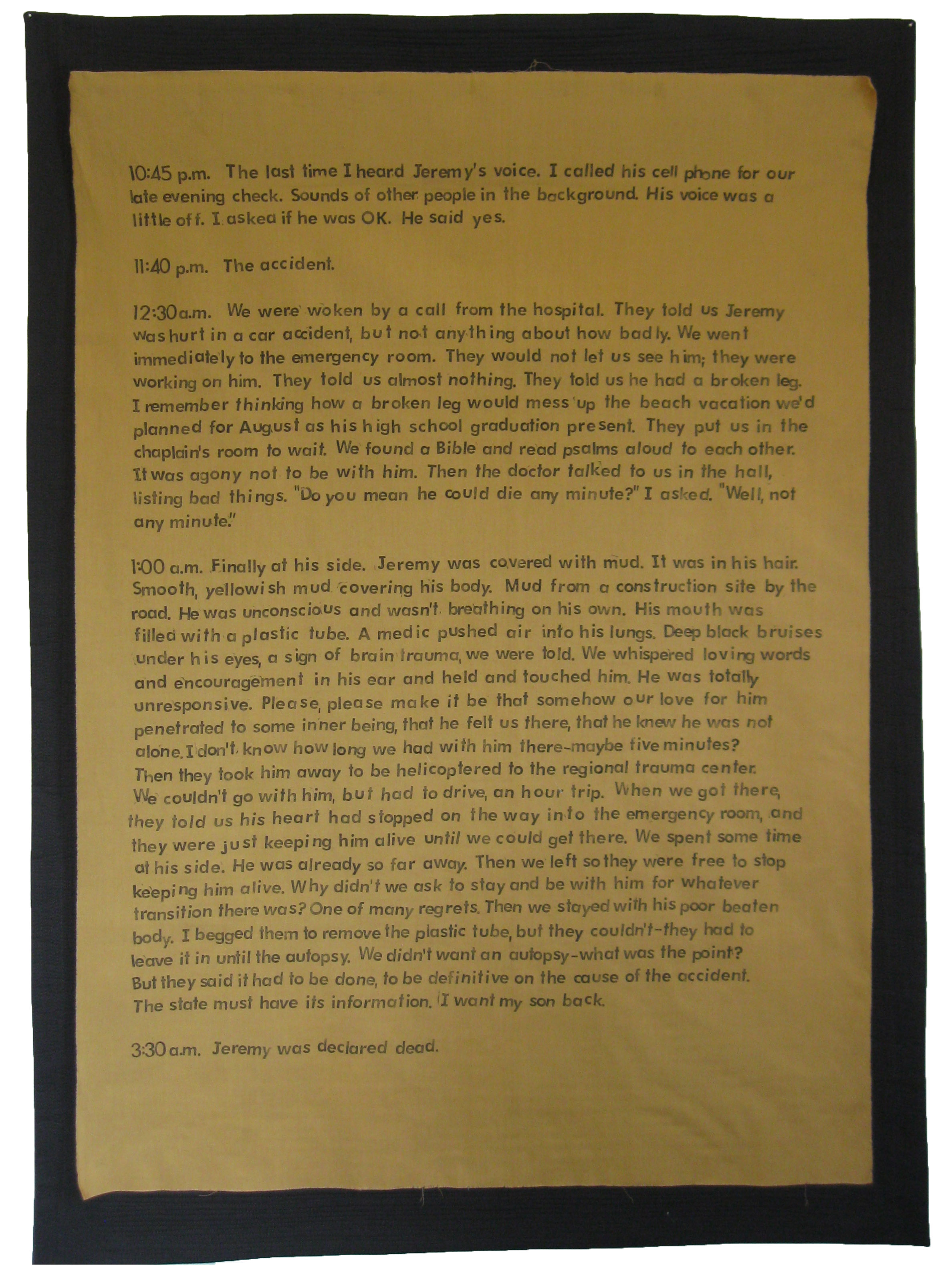
Accident
(2015)
Stamped
with
ink, hand-dyed cotton, machine quilted
35
x
48 inches
The chronology incorporated into this piece was written shortly after the accident (July 17, 2004). Ten years later, in the winter of 2014, I started a quilt that incorporated the text of the narrative. Yes, it was already written on paper, but paper is ephemeral. Having it in a quilt secures it for me. And it makes it visible to others. As I worked on the design, I decided that I wanted lettering that was readily legible, while also incorporating the personal mark of my hand. I planned to stitch the letters, and did a number of trials with different threads, and different styles of stitching. Then I thought of making my own stamps to make the letters. Before investing time in that, I bought an inexpensive set of alphabet stamps for a trial. I found the process of stamping very satisfying—the careful lining up of the stamp, the steady and firm pressure of my hand on the stamp onto the cloth, the combination of regularity (the stamp) and irregularity (the deviations from the line, the differential pressure—a necessary result of my hand). And the simplicity of the stamps I had purchased was satisfying to me. If I made my own stamps, attention would be drawn to whatever personal style I put into them. I liked the quiet anonymity of the commercial stamp.
I
intend
for the viewer to stand before the quilt and read each word. Many
design choices were made with this purpose in mind, including the
overall format as a page of text. The space between
letters, between lines, around the edges of the text—all were
intended to evoke a printed page.
The
color
of the cloth is the color of the mud that covered Jeremy's body
after the accident. I dyed many pieces of fabric before I came to
the color that matched the evidence I kept as well as my memory of
it. I incorporated much of this fabric into the back of the quilt.
The
color also worked with the idea of a printed page—perhaps a darker
piece of parchment, or a page of paper, darkened with age.
This
piece is not a quilt, which by definition is supposed to be three
layers: a front, a back, and some kind of batting or other layer in
between. When I finished the top, I realized that I wanted to keep
it as simple as possible; I wanted nothing to get in the way of
reading the text as the viewer stands before the piece.
I decided on a black backdrop, just for the sake of setting
the piece off from the wall. And I quilted that backdrop, in part so
that I could show the piece in a juried quilt show.
As
I was working on this piece, I wondered if it was appropriate to
show it publicly. Why would I do it? Was it self-indulgent? Overly
obsessive? Maybe it was enough to just make it for myself and put it
away. Then I opened a recently published book by Renato Rosaldo, The
Day of Shelly's Death: The Poetry and Ethnography of Grief.
Shelly and Renato were anthropologists at Stanford when I was a
graduate student there, and I knew Shelly from interdisciplinary
feminist gatherings. She died in an
accident in 1981, falling to her death on a mountainous trail in the
Philippines. So when I saw an announcement for Renato's book, I
sought it out. I was stunned when I opened the book. It begins with
a timeline of Shelly's death—much akin to the chronology I had
written of Jeremy's death. I looked again at the date of her death,
and subtracted it from the date of publication (2014).
Thirty-three years. I wasn't crazy. If Renato was replaying
the timeline thirty-three years after Shelly's death, I was OK doing
it for Jeremy after ten years.